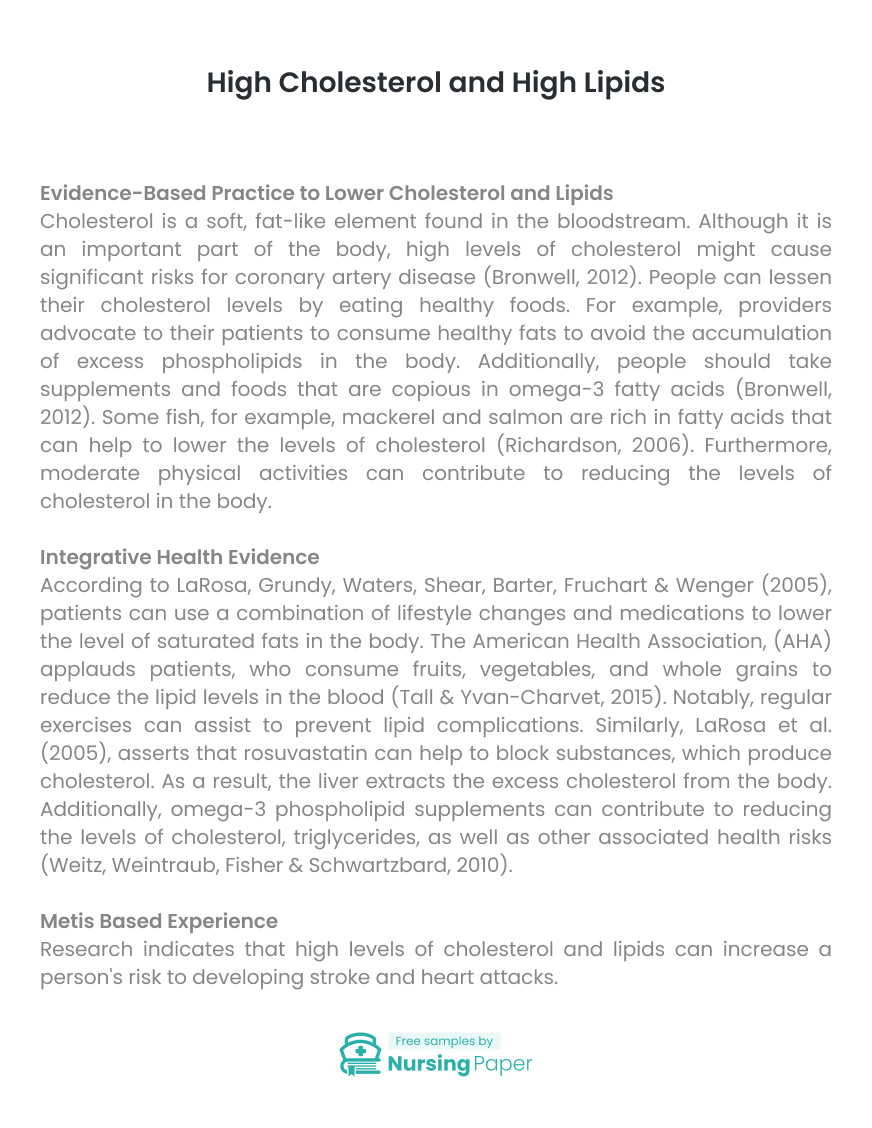
High Cholesterol and High Lipids
Evidence-Based Practice to Lower Cholesterol and Lipids
Cholesterol is a soft, fat-like element found in the bloodstream. Although it is an important part of the body, high levels of cholesterol might cause significant risks for coronary artery disease (Bronwell, 2012). People can lessen their cholesterol levels by eating healthy foods. For example, providers advocate to their patients to consume healthy fats to avoid the accumulation of excess phospholipids in the body. Additionally, people should take supplements and foods that are copious in omega-3 fatty acids (Bronwell, 2012). Some fish, for example, mackerel and salmon are rich in fatty acids that can help to lower the levels of cholesterol (Richardson, 2006). Furthermore, moderate physical activities can contribute to reducing the levels of cholesterol in the body.
Integrative Health Evidence
According to LaRosa, Grundy, Waters, Shear, Barter, Fruchart & Wenger (2005), patients can use a combination of lifestyle changes and medications to lower the level of saturated fats in the body. The American Health Association, (AHA) applauds patients, who consume fruits, vegetables, and whole grains to reduce the lipid levels in the blood (Tall & Yvan-Charvet, 2015). Notably, regular exercises can assist to prevent lipid complications. Similarly, LaRosa et al. (2005), asserts that rosuvastatin can help to block substances, which produce cholesterol. As a result, the liver extracts the excess cholesterol from the body. Additionally, omega-3 phospholipid supplements can contribute to reducing the levels of cholesterol, triglycerides, as well as other associated health risks (Weitz, Weintraub, Fisher & Schwartzbard, 2010).


Metis Based Experience
Research indicates that high levels of cholesterol and lipids can increase a person’s risk to developing stroke and heart attacks. I enlightened a family member, suffering from cardiovascular, and (CVD) disease on how they can lower their lipid levels. Notably, CVD victims can use a combination of regular exercises, weight loss programs, and medications to enhance their standard of health. Because of low lipid levels, people are less susceptible to coronary artery diseases. In this case, the individuals are less likely to suffer from stroke and heart illnesses. According to Tall & Yvan-Charvet (2015), bile acid sequestrants, such as colestipol can help to reduce the amount of cholesterol that can be absorbed from the blood.
The Brand, Dosage, and Preparations to Treat Lipids and Cholesterol
Statins are the most cost-effective drugs that can be used to reduce LDL cholesterol and prevent the peril of heart complications, stroke, or death (Weitz, 2010). The common statins include rosuvastatin, pravastatin, and simvastatin. According to Tall & Yvan-Charvet (2015), the medications can help to lower LDL levels by approximately 20 percent because the drugs contribute in preventing plaques from rupturing. Medical providers indorse a range dose of 10-20 milligrams of rosuvastatin on daily basis, which can help to lower LDL cholesterol by nearly 50-55 percent. Essentially, lower levels of LDL results to better cardiovascular outcomes. Alternatively, victims can use a combination of a low-dose statin and ezetimibe to help manage high cholesterol
Recommendations to Patients
As a Nurse Practitioner I would recommend to my patients to engage in a regular exercise and to consume low-fat diets which aids in the reduction in the levels of lipids and fatty acids. Additionally, statin medications can help to decrease cholesterol levels in the blood. Therefore as a Nurse Practitioner I would recommend patients to take Rosuvastatin 10mg for two times in a day. Additionally, I would indorse patients to take fish oil as supplements once daily to reduce the levels of lipids in the blood. Particularly, fish containing omega-3 fatty acids that are crucial for improving the health of a person.

1. Bronwell, L. (2012). Fish Oil’s Health Benefits. Life Extension.
2. LaRosa, J. C., Grundy, S. M., Waters, D. D., Shear, C., Barter, P., Fruchart, J. C., & Wenger, N. K. (2005). Intensive lipid lowering with atorvastatin in patients with stable coronary disease. New England Journal of Medicine, 352(14), 1425-1435.
3. Tall, A. R., & Yvan-Charvet, L. (2015). Cholesterol, inflammation and innate immunity. Nature reviews. Immunology, 15(2), 104.
4. Weitz, D., Weintraub, H., Fisher, E., & Schwartzbard, A. Z. (2010). Fish oil for the treatment of cardiovascular disease. Cardiology in Review, 18(5), 258.



The download will start shortly.

The download will start shortly.
 Subject:
Nursing
Subject:
Nursing  Number of pages: 2
Number of pages: 2  Subject:
Health and Social Care
Subject:
Health and Social Care  Number of pages: 2
Number of pages: 2  Subject:
Medicine
Subject:
Medicine  Number of pages: 2
Number of pages: 2  Subject:
Health and Social Care
Subject:
Health and Social Care  Number of pages: 2
Number of pages: 2  Subject:
Nursing
Subject:
Nursing  Number of pages: 3
Number of pages: 3  Subject:
Health and Social Care
Subject:
Health and Social Care  Number of pages: 6
Number of pages: 6  Subject:
Nursing
Subject:
Nursing  Number of pages: 2
Number of pages: 2  Subject:
Nursing
Subject:
Nursing  Number of pages: 5
Number of pages: 5  Subject:
Nursing
Subject:
Nursing  Number of pages: 6
Number of pages: 6  Subject:
Nursing
Subject:
Nursing  Number of pages: 9
Number of pages: 9  Subject:
Medicine
Subject:
Medicine  Number of pages: 3
Number of pages: 3  Subject:
Health and Social Care
Subject:
Health and Social Care  Number of pages: 4
Number of pages: 4  Subject:
Health and Social Care
Subject:
Health and Social Care  Number of pages: 9
Number of pages: 9  Subject:
Nursing
Subject:
Nursing  Number of pages: 5
Number of pages: 5  Subject:
Medicine
Subject:
Medicine  Number of pages: 2
Number of pages: 2 
